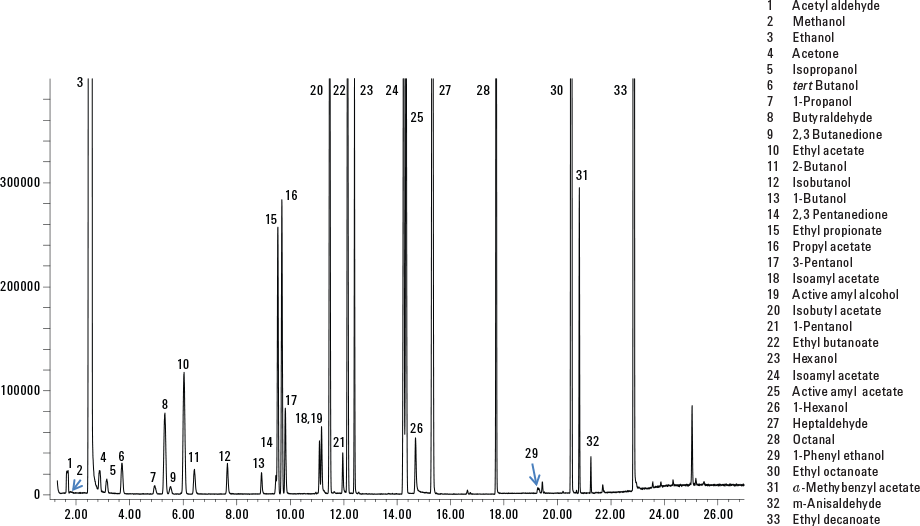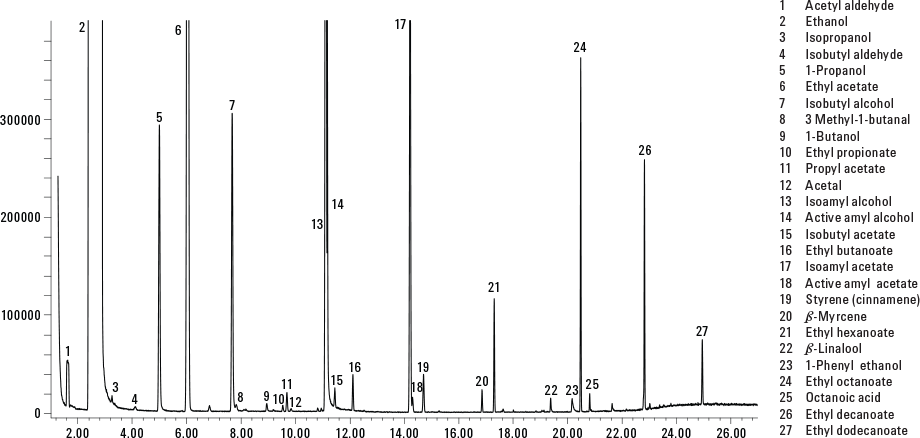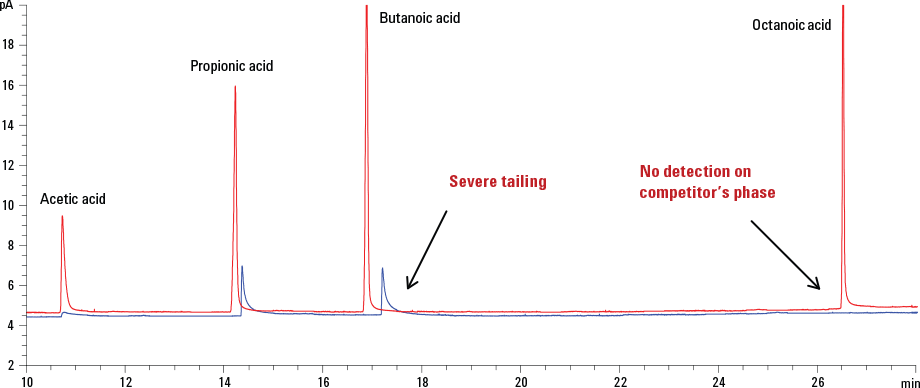Access Agilent eNewsletter January 2016

What is in your beer? Find out using a Agilent J&W DB-624 Ultra Inert (UI) column with GC/MS static headspace solution
Ken Lynam, Agilent R&D/Applications Chemist
Static headspace gas chromatography/mass spectrometry (GC/MS) is an excellent way to profile alcoholic beverages such as a centuries old favorite malted barley beverage—beer. The components in beer are as diverse as the individual yeast strains and varietal hops that are on the list of ingredients. The craft of making fine beer requires knowledge of the flavor components that are positive indicators of a good beer and those that are not. Static headspace GC/MS is an excellent technique to identify and monitor flavor components at trace levels, but it requires an inert GC column that reliably delivers sample components to the MS. Agilent J&W DB-624UI columns provide outstanding performance for this application.

Figure 1. Standard chromatogram of alcohols, aldehydes, and esters on an Agilent J&W DB-624UI column shows sharp, well-defined peaks.

Figure 2. Total ion chromatogram of a neat light lager beer sample added to a 20 mL headspace vial. GC column was an Agilent J&W DB-624UI, 30 m × 0.25 mm, 1.4 µm.

Figure 3. Total ion chromatogram of a 10 mL neat pale ale sample in a headspace vial on an Agilent J&W DB-624UI, 30 m × 0.25 mm, 1.4 µm GC column.

Figure 4. FID traces of a 1 ng/acid component on an Agilent J&W DB-624UI column and a competitor’s traditional 624 phase. Note the improved peak shape and superior detection on the Agilent column.
Chromatograph troublesome organic acids
A number of the components in beer can be a challenge to separate and chromatograph. The mix of components includes fusel oils, aldehydes, esters, and organic acids. The polarity of a 6% cyanopropylphenyl stationary phase has been a traditional choice for this type of analysis. However, peak shapes and low-level detection of organic acids have been problematic for this phase. To overcome this difficulty, Agilent uses a new deactivation procedure for its 6% cyanopropyl dimethylpolysiloxane phase (624 phase). As a result, the highly inert Agilent J&W DB-624UI columns deliver consistent and superior performance for organic acids.
Static headspace GC/MS chromatograms of beer and spirits illustrate the value of a highly inert Agilent J&W DB-624UI column for this type of analysis. This column is successful with the separation of amyl and isoamyl alcohols and their esters, and delivers sharp peaks for aldehydes and organic acids. Headspace profiles can be a tremendous aid in understanding flavor development, tracking flavor stability, and authenticating fine crafted alcoholic beverages.
Straightforward analysis with excellent peak shapes
To prepare for headspace analysis, we added 10-mL aliquots of each beer sample to 20 mL crimp cap headspace vials. We analyzed the samples with an Agilent 7890A GC interfaced with an Agilent 5975C Series GC/MSD equipped with a 111-position Agilent 7697A Headspace Sampler.
Screen popular beers using GC/MS static headspace
The total ion chromatogram of a lager-style beer is shown in Figure 2, while that of a pale ale is displayed in Figure 3. The chromatograms show several components contained in the standard mix, as well as some additional peaks. There is no evidence of the peak tailing often observed when you analyze reactive compounds such as aldehydes and organic acids.
What is unique about the Agilent J&W DB-624 Ultra Inert column?
Figure 4 shows a comparison between an Agilent J&W DB-624UI GC column and a competitor’s column. The competitor’s column gave tailing peaks that made quantification difficult. Worse yet, one peak was totally missing from the chromatogram.
Achieve accurate, reliable results with an inert column
Static headspace GC/MS provides an excellent way to profile various beer styles because it quickly shows both common and unique attributes. GC flow path inertness is an important consideration for the study of the brewing process and volatile flavor elements. When compared with a competitor’s premium priced traditional 624 phase column, the Agilent J&W DB-624UI column demonstrated superior performance for organic acids. For additional details, explore Agilent Application Note 5991-1136EN. Then increase confidence in your results with Agilent Ultra Inert GC Solutions.
Stay informed about the applications that are important to you
Subscribe to Access Agilent
Our free customized
monthly eNewsletter
Article Directory – January 2016
All articles in this issue
 What is in your beer? Find out using a Agilent J&W DB-624 Ultra Inert (UI) column with GC/MS static headspace solution
What is in your beer? Find out using a Agilent J&W DB-624 Ultra Inert (UI) column with GC/MS static headspace solution Moving biologics to market with automated biopharma workflow solution
Moving biologics to market with automated biopharma workflow solution Nobel Prize-winning lab uses Agilent equipment to accelerate natural product discoveries
Nobel Prize-winning lab uses Agilent equipment to accelerate natural product discoveries Tip: How to detect leachables from drug container closures in pharmaceutical products
Tip: How to detect leachables from drug container closures in pharmaceutical products Fast, accurate absolute-quantification of proteins and antibodies with Agilent 8800 ICP-QQQ
Fast, accurate absolute-quantification of proteins and antibodies with Agilent 8800 ICP-QQQ Chevron and Agilent collaborate on new multi-element crude oil analysis technology that delivers advantages in speed, cost, and safety
Chevron and Agilent collaborate on new multi-element crude oil analysis technology that delivers advantages in speed, cost, and safety Ask the Expert: Can I improve the chromatography of basic compounds on my older HPLC systems?
Ask the Expert: Can I improve the chromatography of basic compounds on my older HPLC systems? More pesticides identified using Agilent Pesticide DRS Screening GC/MSD Analyzer with new high efficiency source
More pesticides identified using Agilent Pesticide DRS Screening GC/MSD Analyzer with new high efficiency source Improved peak shapes for active semivolatiles with inert Agilent J&W DB-UI 8270D columns
Improved peak shapes for active semivolatiles with inert Agilent J&W DB-UI 8270D columns
Figure 1

Standard chromatogram of alcohols, aldehydes, and esters on an Agilent J&W DB-624UI column shows sharp, well-defined peaks. Column dimensions were 30 m × .25 mm × 1.4 µm.
Figure 2

Total ion chromatogram of a neat light lager beer sample added to a 20 mL headspace vial. GC column was an Agilent J&W DB-624UI, 30 m × 0.25 mm, 1.4 µm.
Figure 3

Total ion chromatogram of a 10 mL neat pale ale sample in a headspace vial on an Agilent J&W DB-624UI, 30 m × 0.25 mm, 1.4 µm GC column.
Figure 4

FID traces of a 1 ng/acid component on an Agilent J&W DB-624UI column and a competitor’s traditional 624 phase. Note the improved peak shape and superior detection on the Agilent column.